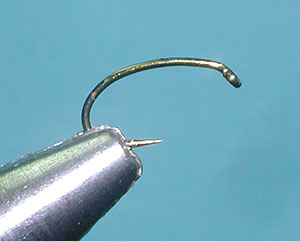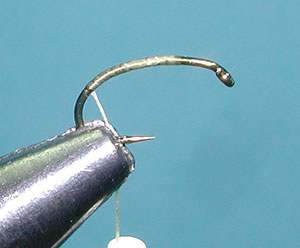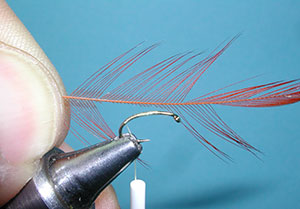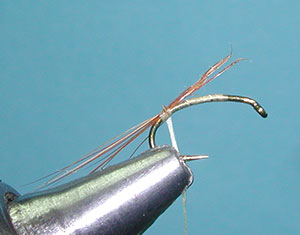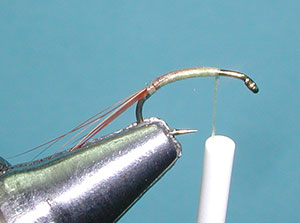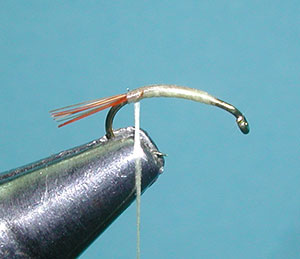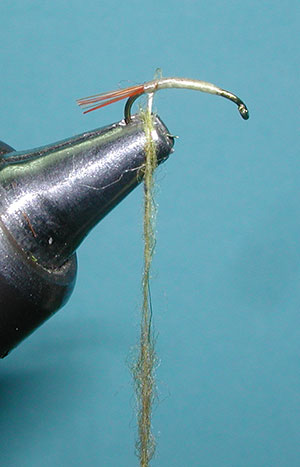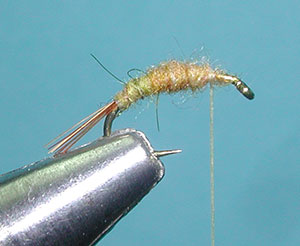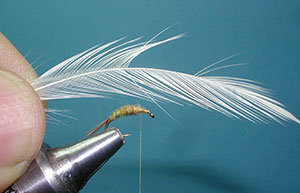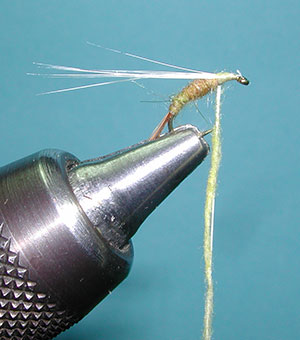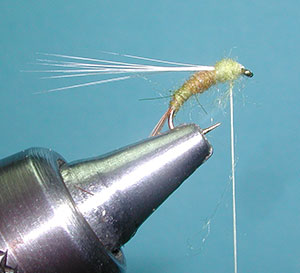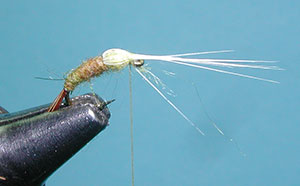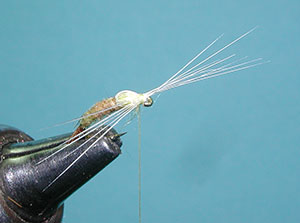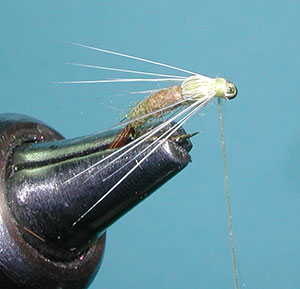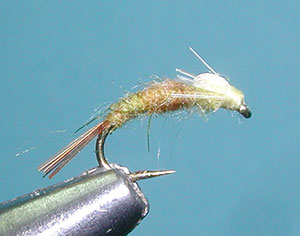Barr Emerger – simple adaption to a wet or dry pattern
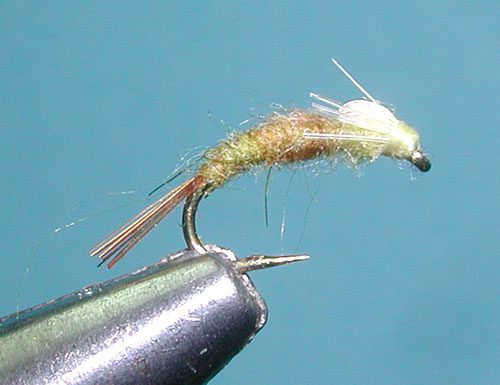
Barr Emerger, PMD (Wet)
Tying Instructions
| Materials
to Order Material, click the link |
|
|---|---|
| Hook | TMC 2487 #16-20 |
| Thread | Veevus 10/0 Light Cahill |
| Body | Olive Brown Superfine |
| Thorax | PMD Superfine |
| Tail | Brown Spade Hackle Fibers |
| Wingcase | Pale Olive or Cream Hackle Fibers |
| Legs | Pale Olive or Cream Hackle Fibers |
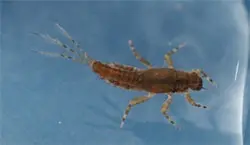
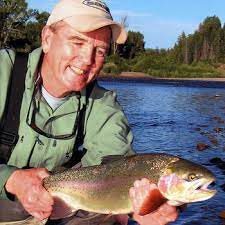
John Barr
Barr Emerger
John Barr created this pattern in 1975 while fishing upon the Nelson’s Spring Creek in Montana. Noticing that he was getting little interest in a PMD hatch with his dry patterns, he used a nymph and finally caught a trout. Upon pumping the stomach, John noticed that partially hatched nymphs with the shuck still attached were present on the back of the trout’s tongue.
John developed his emerger pattern based upon the appearance of these partially developed duns and created his Barr Emerger. One aspect of note is the use of the wingcase hackle also being utilized for the legs. This is a technique that Andre Puyans used with his AP Nymphs in the 1980’s.
Wet Version
I don’t know if John was the first to come up with this tying technique for nymphs but it allows for a quick and simple tie. Colorations were adapted for both PMD and BWO mayflies. John uses both a “wet” version tied upon a TMC 2487 larvae type hook and a “dry” version using a TMC 101. If a bead is being applied to the wet version, consider using a longer, heavier hook such as a Daiichi 1120. This hook will offer a wider hook gap as well. The “dry” version tends to have a longer tail section, usually 3/4 of the shank length and not trimmed. The “wet” version will be used when there is no visible hatch.
Dry Version
If one sees surface activity, John will switch to the “dry” version which lies within the surface film. Later versions of John’s pattern include the use of a flashback material or a bead. The flashback tends to be John’s preferred pattern in most situations. One of the attributes of this pattern that became known, is that the trout do not seem to shy away from it after it has been used a number of times. John has had occasions where he caught the same trout using the same fly. Another attribute to this pattern is that it imitates both an emerging mayfly and a mayfly cripple.
This emerger pattern tends to be a favorite among many of the Sierran streams during BWO and PMD hatches. Since the “dry” pattern is difficult to see on it’s own, it is often used as a dropper from a visible dun pattern. The “wet” type can be used as a similar dropper or as the third dropper as in a hopper-copper-dropper set-up.
Variations
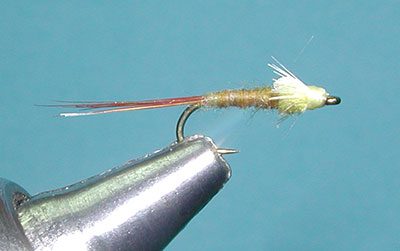
Barr Emerger PMD , dry
| Hook | TMC 101 #14-18 |
| Thread | Veevus 10/0 Light Cahill |
| Body | Olive Brown Superfine |
| Thorax | PMD Superfine |
| Tail | Brown Spade Hackle Fibers |
| Wingcase | Pale Olive or Cream Hackle Fibers |
| Legs | Pale Olive or Cream Hackle Fibers |
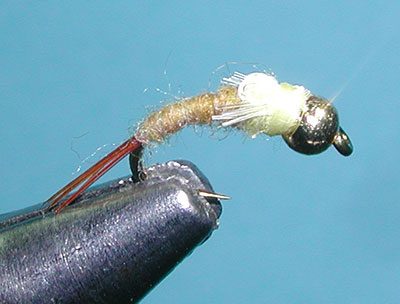
BH Barr Emerger PMD, wet
| Hook | Daiichi 1120 #16-18 |
| Thread | Uni-thread Iron Gray 8/0 |
| Head | 3/32 |
| Body | Olive Brown Superfne |
| Thorax | PMD Superfine |
| Tail | Brown Spade Hackle Fibers |
| Wingcase | Pale Olive or Cream Hackle Fibers |
| Legs | Pale Olive or Cream Hackle Fibers |
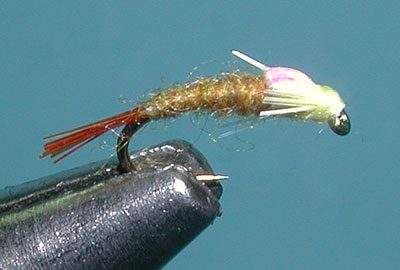
Flashback Barr Emerger PMD, wet
| Hook | TMC 2487 #16-20 |
| Thread | Uni-thread Iron Gray 8/0 |
| Body | Olive Brown Superfine |
| Thorax | PMD Superfine |
| Flashback | Pearlescent Flat Tinsel |
| Tail | Brown Spade Hackle Fibers |
| Wingcase | Pale Olive or Cream Hackle Fibers |
| Legs | Pale Olive or Cream Hackle Fibers |

Barr Emerger BWO, wet
| Hook | TMC 2487 #18-22 |
| Thread | Uni-thread Iron Gray 8/0 |
| Body | BWO Superfine |
| Thorax | Blue Dun Superfine |
| Tail | Brown Spade Hackle Fibers |
| Wingcase | Medium Dun Hackle Fibers |
| Legs | Medium Dun Hackle Fibers |
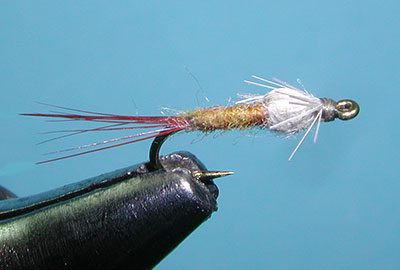
Barr’s BWO Emerger, dry
| Hook | TMC 101 #16-22 |
| Thread | Uni-thread Iron Gray 8/0 |
| Body | BWO Superfne |
| Thorax | Blue Dun Superfine |
| Tail | Brown Spade Hackle Fibers |
| Wingcase | Medium Dun Hackle Fibers |
| Legs | Medium Dun Hackle Fibers |

